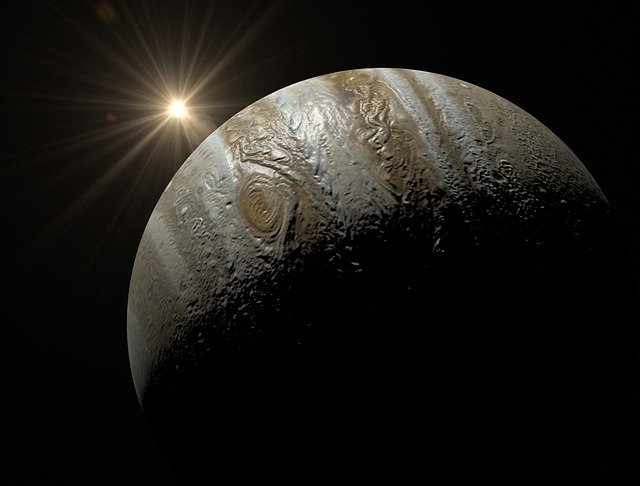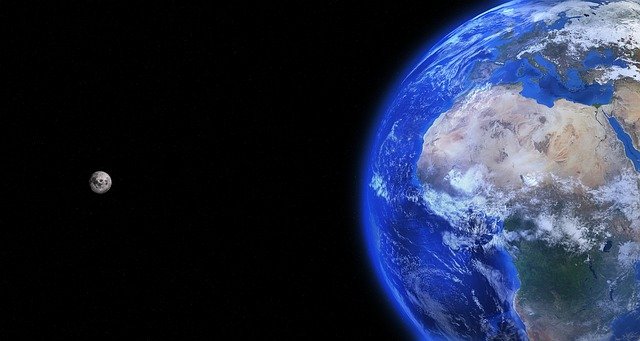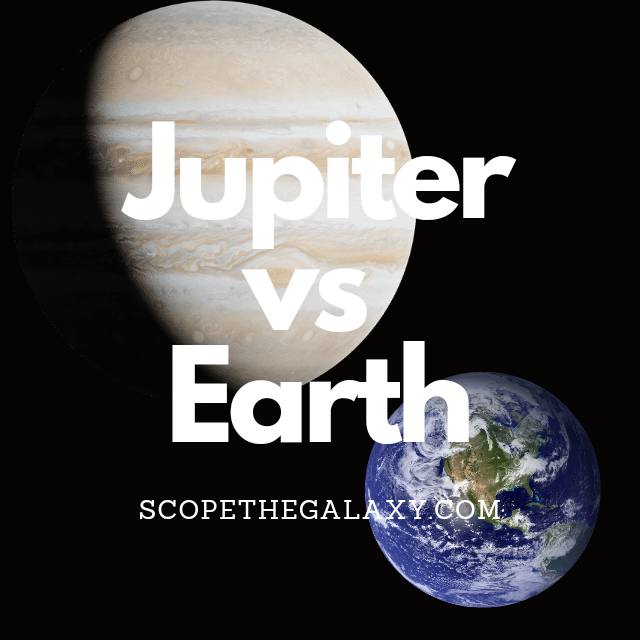*This post may contain affiliate links. This means we may make a commission if you purchase an item using one of our links*
The main differences between Earth and Jupiter is that Earth is a terrestrial planet that can harbour intelligent life whilst Jupiter is a gas giant that cannot, Earth is the 3rd farthest planet from the Sun whilst Jupiter is 5th, Jupiter is the largest planet in our solar system whilst Earth is 5th, Jupiter has 79 moons as opposed to Earth’s singular moon and Jupiter has the strongest magnetic field in our solar system.
There are a variety of other differences between the Earth and Jupiter so continue reading if you want a more thorough breakdown of both entities.
What Is The Planet Jupiter?
Table of Contents

Jupiter is the 5th farthest planet from the Sun and the largest planet within our local solar system. The planets most recognizable trait is the giant red spot visible on its atmosphere along with the brown horizontal bands flowing across its atmosphere.
As a result of its composition and size, Jupiter falls under the classification of a gas giant.
This is because its composition mostly consists of the elements hydrogen and helium. The split is roughly 71% hydrogen, 27% helium, with the remainder of the elements split throughout the left over 2%.
As the biggest planet in our solar system, Jupiter is 139,820 km or 1,300 Earths in diameter, it has a mass of around 0.001 solar masses, the temperature when inside the clouds are roughly -145 degrees Celsius whilst the core is far hotter, equating in the region of 24,000 degrees Celsius.
Due to its extreme circumstances, gaseous composition and distance from the Sun, the planet is not theoretically capable to support life, from its subzero temperature to the extremely fast 640 km/h winds, and its gravity which may be unsustainable for our bones, roughly 2.4 times greater than Earth’s.
Although the conditions on Jupiter aren’t suitable for us, some of its 79 moons like Europa for example could support life.
This brown giant has a relatively fast rotation around its axis where 1 rotation typically takes 10 hours to make whilst its orbit around the Sun is far longer taking in the region of 12 years for 1 full cycle.
Another feature of Jupiter that is renowned by astronomers is the strength of its magnetic field. In comparison to the other planets in our solar system it is even stronger than our Sun, where it’s over magnetosphere is roughly 20,000 times the strength of Earth.
What this means is that Jupiter’s magnetosphere is able to avert solar winds that are 3 million kilometers away from it.
What Is The Planet Earth?

Our home planet Earth is the 3rd farthest planet from the Sun, made up of a mixture of water and solid rock like objects, and is the only entity in our solar system known to allow intelligent life forms like ourselves to exist.
Earth’s distance of 152 million km from the Sun has allowed it to remain within the goldilocks zone and as a result, the planet has been able to thrive for millions of years. It orbits the Sun in a circular pattern, much like all the other planets, has only one natural satellite which would be the Moon and is a terrestrial planet to boot.
In regards to its diameter, Earth is the 5th largest planet with a diameter 12,742km.
Earth’s temperature ranges based on the region you’re located where it can be from as low as -94 degrees Celsius in Antarctica to as high as 50 – 55 degrees Celsius in Tunisia.
As for the planets composition, it consists of the crust, the mantle, the outer core and the inner core, where the inner core is the hottest element within the Earth reaching temperature in excess of 5,200 degrees Celsius.
In regards to some of its most unique features, Earth is around 71% water, has an atmosphere consisting mostly of oxygen and nitrogen that is also made up of 5 main layers, with the highest to lowest being the troposphere, stratosphere, mesosphere, thermosphere and exosphere.
A day on Earth is 24 hours and an orbital cycle around the Sun takes 365 days to complete. It’s axial tilt is more distinct at 23.5 degrees to the right.
How Are Jupiter And Earth Similar?
Although Jupiter and Earth are more different than similar, they still share a few commonalities, which in this case includes the following:
- Both planets orbit the Sun in a circular pattern
- Both have a hotter central core.
- Both are spherical in shape.
- Both have natural satellites orbiting them.
- Both are part of the same solar system
Differences Between Jupiter And Earth
In regards to the differences between these two planets, they would include the following:
- Earth is terrestrial planet whereas Jupiter is a gas giant
- Jupiter has 79 moons whilst Earth has only 1.
- Jupiter has 4 rings and Earth has 0.
- Earth is 71% water and 29% land whereas Jupiter is made of only gases with helium and hydrogen its most prominent elements.
- Earth is much smaller than Jupiter with a diameter of 12,742km whereas Jupiter has a diameter 139,820km.
- Earth has a temperature that fluctuates based on the region but is around 13.9 degrees Celsius on average whereas the average temperature on Jupiter is -145 degrees Celsius.
- Jupiter’s core temperature is 24,000 degrees Celsius whereas Earth’s temperature is 5,200 degrees Celsius.
- Earth’s gravity is 9.807 m/s² whereas Jupiter has a stronger gravity at 24.79 m/s².
- Jupiter is less dense where its density is 1.33 g/cm³ as opposed to Earth’s that is much larger at 5.514 g/cm3.
- Jupiter’s magnetic field is the strongest in our solar system where it is 4.3 gauss as opposed to Earth’s smaller 0.5 gauss magnetic field.
- A day on Earth is 24 hours whilst a Jupiter day is 10 hours.
- Earth has an axial tilt of 23.5 degrees whereas Jupiter’s axial tilt is 3.13 degrees.
- Earth is the 3rd farthest planet from the Sun whilst Jupiter is the 5th farthest therefore, Earth completes a year in 365 days and Jupiter completes a day in 12 years.
- Earth’s mass is 5.972 × 10^24 kg whereas Jupiter has a mass of 1.89 × 10^27 kg.
Summary
Jupiter and Earth are very different from one another whether it be there differences in size, weight, gravitational and magnetic strength, their overall composition and of course their overall ability to harbor intelligent life where of course our home planet does.
Therefore, it is clear to see why these planets are very different from one another even if the energy they share comes from the same star.

